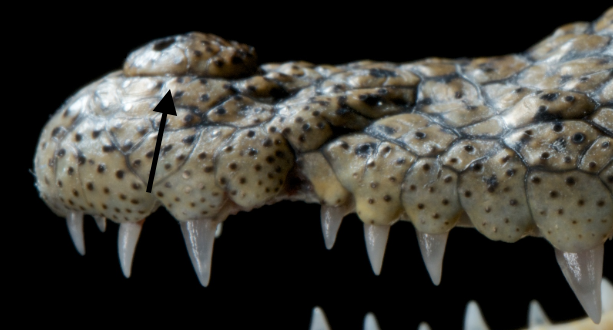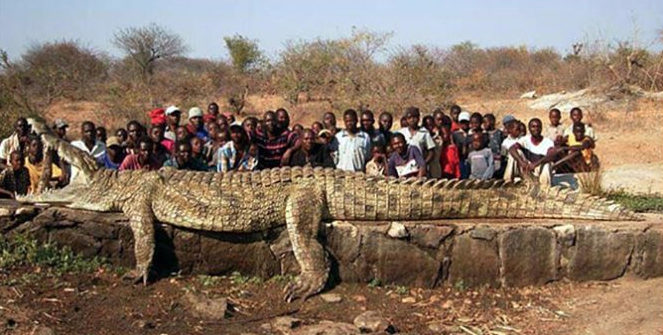The Nile Terrors
by Dylan Aaronson, 7th grade

Nile crocodiles have some interesting facts about them. One is that these reptiles can hold their breath for a couple of hours without any damage to the body or brain. On some occasions, crocs are able to slow down their metabolism. This means that when a food supply is low, or they can’t find anything to eat, they will not be so hungry. With this ability, some of the largest of the crocodiles only eat a few times a month.
Nile crocodiles reach adulthood at about 11 years old but they will hunt on small insects at day one, when they emerge from their eggs. Later, they employ death rolls – a super move for a hunting croc. Once they sneak up on their prey, they will lunge out of the water at any place they can get their mouth on them. Once they have a firm grip, they lock their jaw and move into a sideways 360 spin. This can tear just about any prey limb to limb.

A female will look after her hatchlings as soon as they’re born but only until they turn two years of age. Even though mothers will do their very best, only 1 percent will make it to adulthood. During this time, they are at the bottom of the food chain, putting them in a dangerous position. They are hunted by birds, monitor lizards, snakes, foxes and fish. If there are more nests in the area, females will put all the babies together and they will work together to protect them. Nile crocodiles, as full sized males, may grow from 11 to 18 feet as adults! The females are smaller, generally only growing up to a maximum of 13 feet, but they may grow more. Depending on what climate a croc is living in, they grow to different sizes. The size of the croc depends upon their habitat: the warmer and clammier the soil and mud, the larger and more horrible they become, and the drier and colder, the more wimpy the crocs are.

Nile crocodiles, despite their passion for meat, would be very good at taking pills, because they cannot chew, meaning their jaws can only move up and down, but not sideways. This means that once they tear off a chunk of meat from their prey, they swallow it whole. Since they can’t grind their meat, it’s a good thing they can swallow large chunks of stuff – they also swallow rocks to grind meat in their stomach! Crocs have a special acid in their stomach, called hydrochloric acid that can help digest things such as bone, hooves, and horns. This is neutralized by an alkaline solution so that it does not digest a hole into its stomach. Crocodiles sure are hungry – they will eat a wide variety of animals. This may include insects, birds, and a wide variety of rodents. They may also decide to eat fish, or strike at larger mammals. These may include cattle, gazelles, wildebeest, and zebras, and you guessed it, human beings. One study from Charles Darwin University in Australia showed that all Nile crocs average about 350 human attacks a year with a 56.5% fatality rate. Even in this modern era, with humans basically dominating the world, the Nile crocs still eat about 175 people a year. That means if you visit the Nile – watch out! Don’t become a member of the Darwin Awards! Charles Darwin University is a legit research facility in Australia whereas the Darwin Awards are funny videos of epic fails whose motto is: “Chlorinating the Gene Pool”.

Zebras are significantly larger and harder to catch and eat, than say, snapping turtles. To get a large meal, a crocodile will swim up on its prey and then ambush it. Of course, because they can’t masticate their food, they must tear it into bite-size chunks with repeated death-rolls. As you can see above, sometimes other crocs join in and celebrate a feast with the killer hero. Of course, one wonders how he or she feels when their massive lunch has to be split into so many shares. Also, how could they perform death-rolls so close together?

As crocs live in different places, the food they can catch may vary, and they rely on several key senses. Nile crocs can catch just about anything that comes into their hunting area, which are African bodies of water. Nile crocodiles have an incredible sense of smell, and are known to track the scent of rotting animals, going extreme distances just for a dead meal. Aside from that special super sense, crocs have another one. On its body, the crocodile has little pressure receptors. These can feel the tiniest movement in the water. They are most clearly visible on top of the croc’s snout. The small black sensory pits, known as domed pressure receptors, help crocs to feel tremors or spasms under water that they can’t actually see.

Nile crocodiles do not reach a maximum size, so they continue to grow as their life goes on. No matter how old a Nile crocodile is, it continues to grow in length and weight. Henry the crocodile, born in the Okavango Delta in Botswana, turned 118 in January 2019, weighs 500 kilograms, and is 5 meters long. This means he is 1,100 pounds, and is just short of 20 feet. Henry, the three-year-old croc, was on a killing spree in Botswana, so the tribe got an elephant hunter to catch him in 1903. Because these crocs can live so long, humans are still discovering how big and heavy they can grow up to be. There are records that say some wild crocs are up to 6 meters in length and 900 kilograms. This just shows that crocs will keep on growing until they die.


Charles Darwin link: http://www.crocodile-attack.info/about/human-crocodile-conflict
